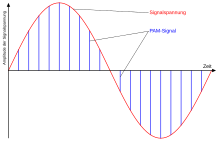Pulse amplitude modulation
The pulse amplitude modulation ( PAM ) is an analog modulation method . With pulse amplitude modulation, the analog message signal is regularly sampled, its signal level is measured and pulses are generated in the same rhythm, the amplitude of which corresponds to the signal strength. The PAM signal is time-discrete and value-continuous.
The pulse amplitude modulation is suitable for transmission systems with analog multiplex methods. In the time between the individual PAM pulses of a message signal, the PAM pulses of other message signals can be transmitted. Because of its high sensitivity to interference, PAM is not suitable as a transmission method over long distances. The pulse height is strongly influenced by the interference in the transmission path, so that a falsified signal can arrive at the receiving end. PAM was partly used with older telephone systems .
Pulse amplitude modulation is the preliminary stage to pulse code modulation (PCM). With PCM, the amplitude values of the PAM are also quantized , i.e. H. converted into a digital bit sequence. This bit sequence can be stored or transmitted as a digital signal from a transmitter to a receiver.
Use case Ethernet
Some versions of the Ethernet standard use pulse amplitude modulation. For 100BASE-T1, 100BASE-T4, 1000BASE-T1, BroadR-Reach Ethernet a three-level (PAM-3), for 400G Ethernet a four-level (PAM-4), for 10BASE-T, 100BASE-T2 , 1000BASE-T a five-level ( PAM-5 ) and a 16-level (PAM-16) pulse amplitude modulation is used for 2.5GBASE-T, 5GBASE-T, 10GBASE-T, 25GBASE-T, 50GBASE-T Ethernet.
future
PAM-4 is a standard that was planned as a modulation method for fiber optic transmission in 2014 .
In addition, PAM-4 will also be used for PCI Express 6.0. (Status: 2019)
Individual evidence
- ↑ Transmission technology, author collective, transpress VEB Verlag für Verkehrwesen, 8th edition 1990, p. 174
- ↑ Telecommunications, Beuth / Hanebuth / Kurz / Lüders, Vogel Fachbuch, 2nd edition 2001, p. 111
- ↑ a b Nachrichtenentechnik, Herter / Lörcher, Hanser Verlag, 6th edition 1992, p. 114
- ↑ NIKHIL JAIN: PAM & Ethernet: A perfect match. Retrieved February 24, 2019 .
- ↑ Martin Rowe: The next generation's modulation: PAM-4, NRZ, or ENRZ? In: EDN Network . March 16, 2014.
- ↑ PCI-SIG Announces PCIe 6.0, up to 256 GBps in 2021 . PCISIG. Retrieved June 24, 2019.
